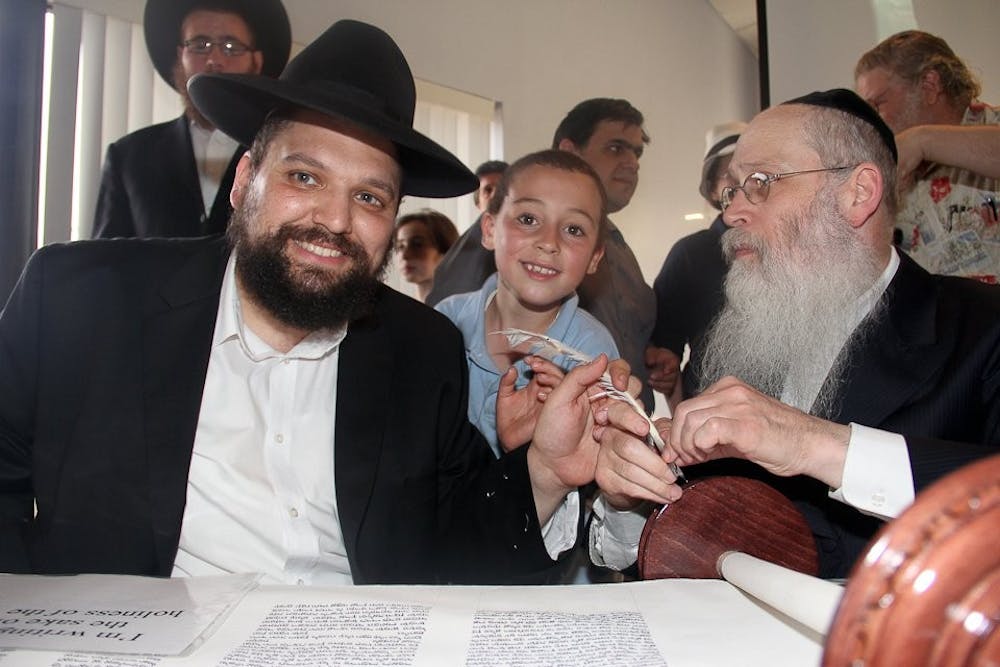With a Catholic upbringing, I haven’t had a lot of exposure to Judaism. Yes, I attended a bar mitzvah here and there during middle school, but that just meant I self-consciously watched and repeated what everyone else in-the-know was doing. So upon the suggestion of a friend, I decided to attend Shabbat at the Rohr Chabad House last Friday.
Shabbat is primarily a day of rest and spiritual enrichment, and a time when those who practice the faith can set aside their weekday concerns and devote themselves to higher pursuits.
When I walked into the Chabad House, Rabbi Shmuel Tiechtel greeted me warmly and enthusiastically (though when I put my hand out to shake his he respectfully explained that Orthodox Jews do not touch people of the opposite gender besides the one they are married to—whoops).
Everyone welcomed me with smiles and “Good Shabbos” (Shabbos meaning ‘Sabbath’). I looked around and saw all the women were wearing longer skirts and dresses, so I asked another girl if I was dressed appropriately. She explained that the more conservative believers would consider my pants as men’s clothing.
Well, I hadn’t been there five minutes and I was already the cross-dressing, handshaking attemptress. Clearly, I have perfected the art of first impressions.
But actually, my concerns of judgment were immediately dispelled by everyone’s friendliness and openness.
Chana, the rabbi’s wife, called me over with the other women to take part in the candlelight ceremony, which is done at the beginning of Shabbat each week. During the ritual, we lit a candle and then waved our hands three times towards us as if to bring the light closer. The gesture is meant to draw the spirituality and holiness of Shabbat into a woman’s home and into her life. We then covered our faces as a special blessing was said. As Rabbi Schmuel explained to me later, this ceremony is only for women because “the women are the light in the world.”
We then started the service, and later, the meal.
What stood out to me was:
Shema: considered the most important prayer by Orthodox Jews, the Shema is an affirmation of Judaism and a declaration of faith in one God. Practicing Jews recite the prayer in the morning and night.
Seating: during the service, women sat on the right and men sat on the left separated by a row of potted trees so as to block the view of each other.
Ten men: a Jewish service requires 10 men to be present. When I learned this I, of course, asked why not 10 women? The rabbi explained that since women are the primary caretakers for children, they are allowed to be excused from service when they need to be. He also told me that men have more obligations in Judaism because men are “naturally more animalistic and bestial than women. Men need more reminders about God, while women are more spiritually sound and mystical.”
Tzitzis: the rabbi wore the white tassels on either side of his pants to symbolize that God is all around us.
Kiddush: after the service, Rabbi Shmuel recited the prayer over the wine to sanctify Shabbat.
Handwashing: before the meal, we washed our hands by filling a cup with water and pouring it over each hand three times. Prior to drying, each of us recited a blessing (my Hebrew accent is still a work in progress).
The number three: during the Candlelighting ceremony and handwashing, gestures are done three times because the number ‘3’ in Hebrew has the meaning ‘connection’ and ‘commitment’ attached to it.
Silence: between washing our hands and breaking the bread, there is no talking as to extend the prayer that was just said (keeping quiet also turns out to be a work in progress for me).
Matzah ball soup: Delicious.
Sigma Alpha Mu: the Jewish fraternity that sponsored the Shabbat. Props to these guys for answering my slew of questions throughout the night.
The night ended with a group of us talking about where we from, what we believed in, and what preconceptions there might be. When I told Chase Alyeshmerni, also an ASU student and my go to person for all things Jewish, about my preceding apprehension about being an outsider at Shabbat, he explained, "Jewish teachings are geared to living a holy and generous life.” He offered that the Chabad Center is for those who want “to dig deeper into the culture and belief system to see what good there is to offer."
In that case, I chose the absolute right place to be at Friday night.





